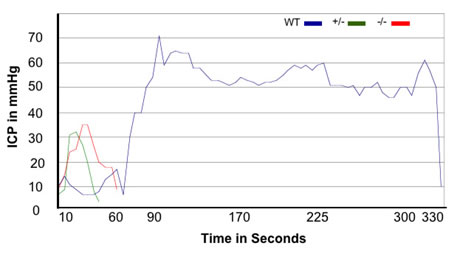Novel Targets in Treating Erectile Dysfunction
Description:

| Courtesy Lysiak, Palmer,
Kavoussi |
| Figure 1. Heterozygote and
knockout mice are unable to maintain erections. When the cavernous nerve
is stimulated, wild type mice (blue) are able to maintain high
intracavernous pressures (ICPs) for approximately five minutes, whereas
both heterozygote (green) and knockout (red) mice are only able to
initiate a blunted ICP response without the ability to sustain an
erection. |
Erectile dysfunction (ED) is a major health problem affecting approximately
30 million men in the United States. Population-based estimates of ED prevalence
and current use trends show the cost of treatment nationwide could reach $15
billion if all men with ED sought treatment. The number of men with ED will
double within the next 20 years as the male population ages. This, together with
the fact that awareness of this condition is on the rise, will undoubtedly
increase the number of patients seeking treatment.
The current clinical
guidelines by the American Urological Association recommend phosphodiesterase 5
inhibitors (PDE5I) as the first line therapy for organic ED. Interestingly,
20–50 percent of ED patients do not respond to PDE5Is. Non-responders do have a
variety of treatment options available, including the use of (1) vacuum
constriction devices, (2) alprostadil intraurethral suppositories, (3)
intracavernous drug injections and (4) penile prosthetic implant surgery. Many
of these options are invasive, most with relatively high discontinuation
rates.
Nitric oxide (NO) is the principal mediator in the erectile
response. NO bioavailability is determined by the activation of nitric oxide
synthase (NOS) isoforms. Potential targets in the treatment of erectile
dysfunction may be a protein or proteins that regulate NOS activity through
post-translational modification. Pharmacologically targeting novel enzymes
upstream of the targets of PDE5 inhibition would allow for treatment of PDE5
inhibitor non-responders.
Jeffrey J. Lysiak, Ph.D., and colleagues at the
University of Virginia Department of Urology have discovered an enzyme doing
just that. The team describes this enzyme to be one of the major players in
regulating NOS, and subsequently NO bioavailability, in corpora cavernosum
during the erectile response that influences the physiological processes of
tumescence (rigidity) and detumescence (flaccidity). They researchers have found
this protein in penile tissues in both mouse and human, where it exists in the
same cell type as endothelial NOS (eNOS).
A knockout mouse, or even a
heterozygote mouse having only one copy of the gene to this enzyme, shows a
significant decrease the ability to maintain an erection (see Figure 1). As this
novel target may allow for a therapy to help patients maintain erections, the
pathway may potentially also be manipulated to treat de-tumescence in cases of
priapism or prolonged erections.
In summary, Lysiak and colleagues have
described a mechanism of regulating NO bioavailability during penile tumescence
and de-tumescence. The University of Virginia is actively seeking a commercial
partner interested in aiding in the development of inhibitors to this
enzyme.
Patent Information:
| Title |
App Type |
Country |
Serial No. |
Patent No. |
File Date |
Issued Date |
Expire Date |
Patent Status |
|
|
|
Inventors:
Keywords:
|
